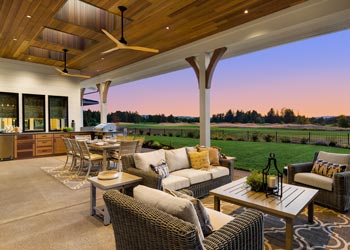Planning An Outdoor Kitchen

Outdoor kitchens have become increasingly popular in recent years, transforming ordinary backyards into functional and inviting spaces for cooking, entertaining, and enjoying the great outdoors.
Whether you're a seasoned outdoor cooking enthusiast or simply looking to enhance your outdoor living experience, careful planning is essential to create a functional and aesthetically pleasing outdoor kitchen.
In this guide, we will delve into the key aspects of designing and planning an outdoor kitchen, including layout considerations, appliance options, and weather-resistant materials.
Kitchen Design, Layout, Appliances, and Materials
Layout Considerations
-
Assess Your Space: Before diving into the design process, assess your available space. Consider the size and shape of your backyard, as well as any existing features, such as patios, decks, or pool areas. A clear understanding of your space will guide the layout and design of your outdoor kitchen.
-
Define the Work Triangle: Just like indoor kitchens, outdoor kitchens benefit from a well-defined work triangle, which comprises the cooking area, preparation area, and the cleanup zone. Arrange these elements in a way that minimizes unnecessary movement and ensures efficiency.
-
Zoning and Functionality: Divide your outdoor kitchen into zones based on functionality. Common zones include: cooking and grilling area, food preparation and countertop space, dining and seating area, storage and utility area, beverage station or bar area.
-
Shelter and Shade: Depending on your location and climate, consider incorporating shelter or shade structures like pergolas, awnings, or umbrellas. These provide protection from the sun, rain, or other elements, allowing you to use your outdoor kitchen comfortably year-round.
Appliance Options
-
Grill: The centerpiece of any outdoor kitchen is typically the grill. Choose a grill that suits your cooking style and needs. Options include gas, charcoal, or even a hybrid model. Built-in grills are a popular choice for a seamless and integrated look.
-
Outdoor Pizza Oven: For pizza enthusiasts, an outdoor pizza oven can be a fantastic addition. These ovens can reach high temperatures and are ideal for cooking pizzas, bread, and other wood-fired dishes.
-
Side Burner and Cooktop: To expand your cooking options, consider adding a side burner or a cooktop. These allow you to prepare side dishes, sauces, or boil water while your main grill is in use.
-
Outdoor Sink: An outdoor sink simplifies food preparation and cleanup. Make sure it's equipped with hot and cold water and a waste disposal system to maintain hygiene and convenience.
-
Refrigeration: Outdoor-rated refrigerators and freezers provide storage for perishables, drinks, and ice. They come in various sizes and can be integrated into your kitchen island or cabinetry.
-
Outdoor Bar: If you plan to entertain frequently, consider incorporating a bar area with a sink, ice maker, and storage for beverages and glassware.
Weather-Resistant Materials
-
Cabinetry and Countertops: Outdoor kitchen cabinets and countertops should be constructed from weather-resistant materials like stainless steel, marine-grade polymer, or stone. These materials are durable and can withstand exposure to the elements.
-
Flooring: Choose outdoor flooring materials that are slip-resistant and easy to clean. Options include pavers, concrete, tile, or natural stone. Ensure proper drainage to prevent water accumulation.
-
Coverings and Roofing: For overhead structures, consider materials like treated wood, aluminum, or vinyl that can withstand exposure to moisture and sunlight. Roofing options include metal, polycarbonate, or shingles, depending on your climate.
-
Outdoor-Friendly Appliances: Opt for appliances designed for outdoor use, as they are built to withstand the elements. Look for appliances with stainless steel construction and weather-sealed components.
-
Lighting: Adequate lighting is essential for safety and ambiance. Install outdoor-rated fixtures that can withstand rain and wind. Consider task lighting for cooking areas and softer ambient lighting for dining and relaxation zones.
-
Ventilation: Proper ventilation is crucial for outdoor kitchens, especially when using a grill or pizza oven. Install an outdoor-rated range hood or ventilation system to remove smoke, odors, and heat.
Additional Tips
-
Permits and Codes: Check with your local authorities regarding permits and building codes for outdoor kitchen construction. Compliance with regulations ensures safety and legality.
-
Budget and Planning: Set a realistic budget for your outdoor kitchen project, including appliances, materials, labor, and any additional features. Plan the project timeline to account for design, construction, and installation.
-
Maintenance: Outdoor kitchens require regular maintenance to ensure they remain in top condition. Clean surfaces, inspect appliances, and cover or protect your outdoor kitchen when not in use.
Outdoor Kitchen Renovations Charlotte, NC
Planning an outdoor kitchen involves careful consideration of layout, appliance selection, and weather-resistant materials. By creating a functional and aesthetically pleasing space, you can enjoy cooking and entertaining in your backyard year-round. With the right design and materials, your outdoor kitchen will become a valuable , enhancing both your lifestyle and the value of your property.
Contact us here or call our team at (704) 607-9783 to get started on your kitchen renovation!

